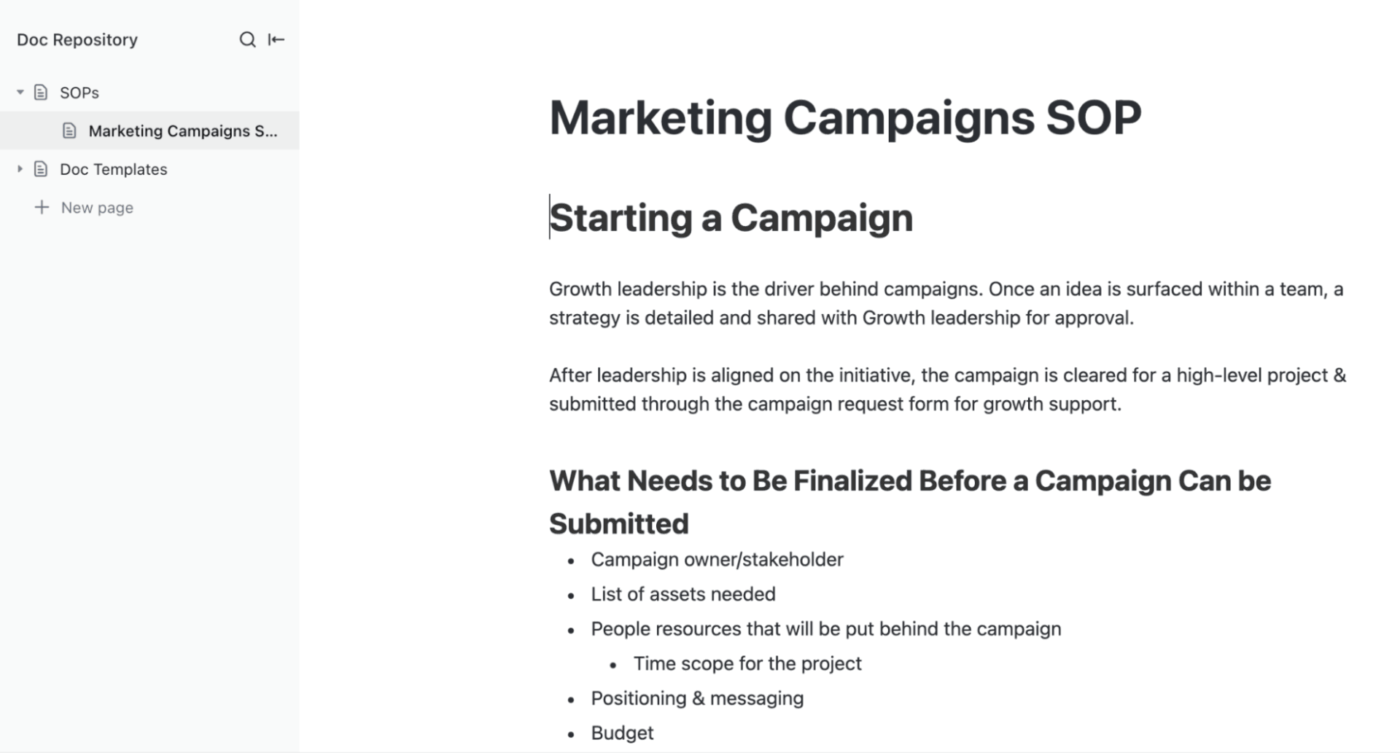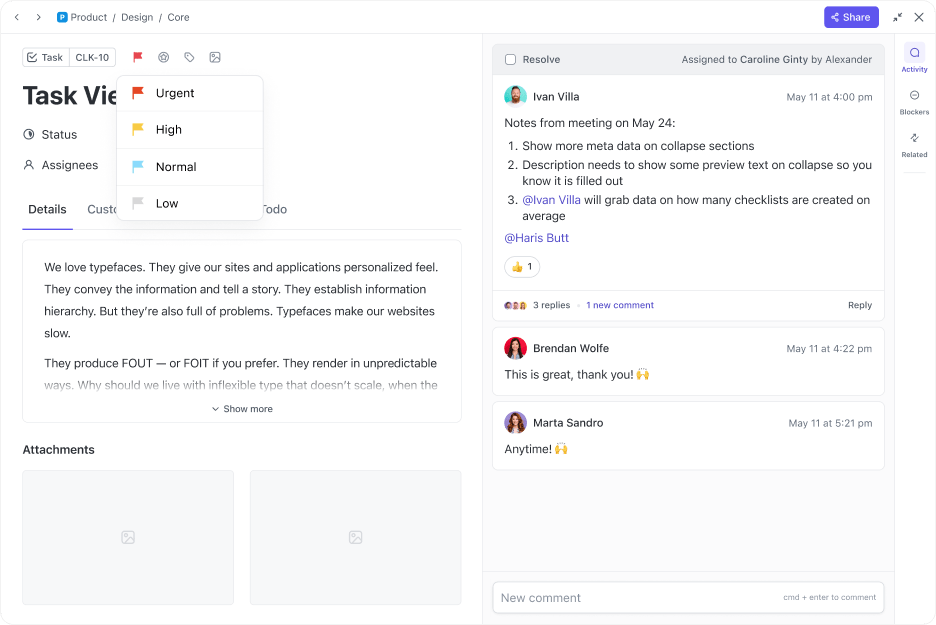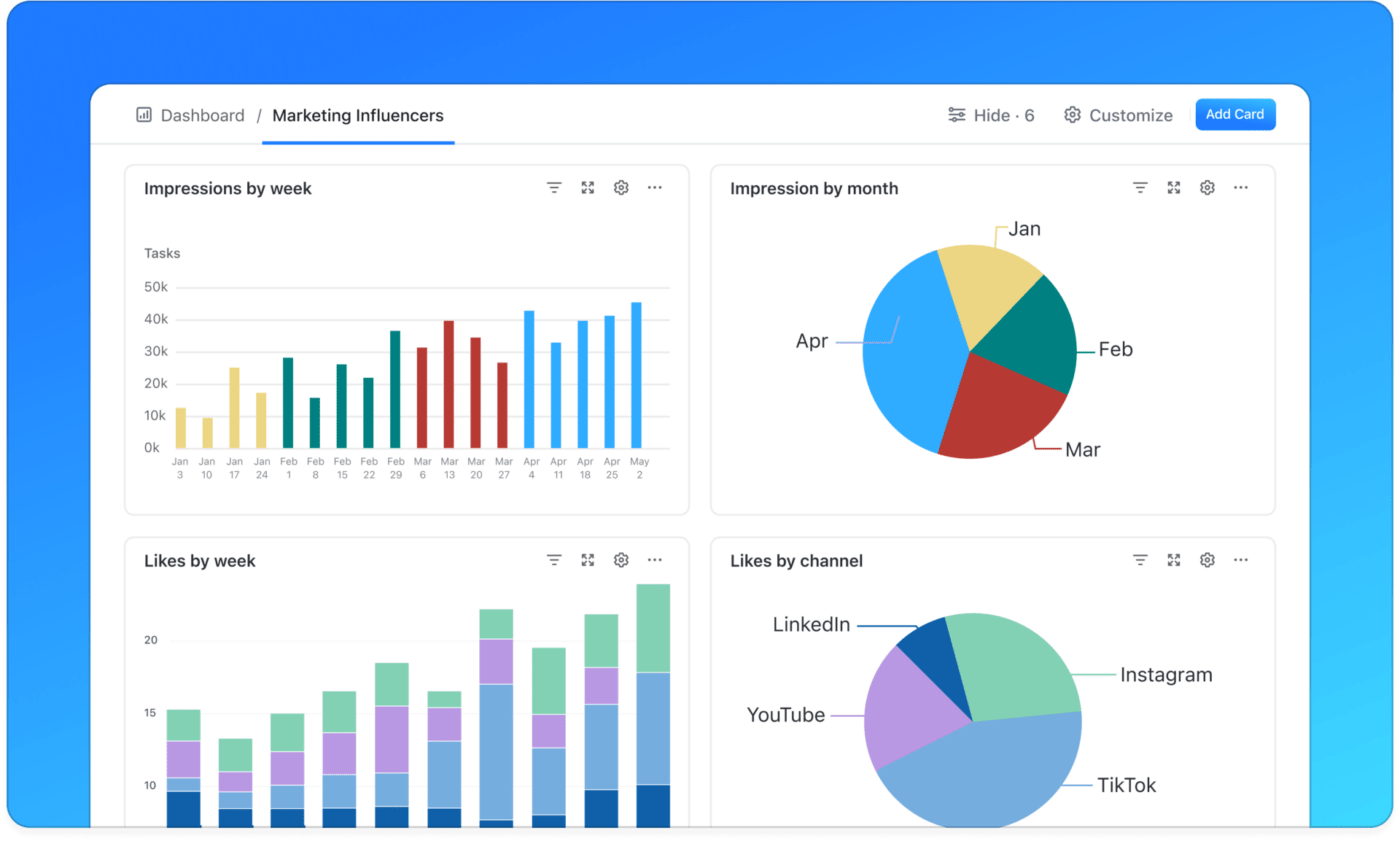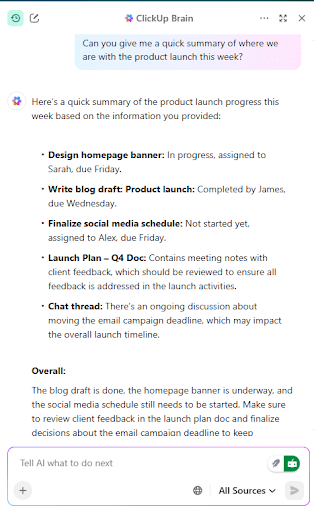Marketing Strategies for Colleges: How to Boost Enrollment in 2025

Sorry, there were no results found for “”
Sorry, there were no results found for “”
Sorry, there were no results found for “”

With college enrollment rates on a constant decline, you know how challenging it is to keep up with your university’s enrollment targets.
Between the shrinking applicant pool, mounting financial risk, and growing skepticism about the value of a degree, higher education marketing is only getting tougher than ever.
If you work in higher education marketing and are looking for ways to turn this challenge into a competitive advantage, this post is for you.
We share practical marketing strategies for colleges and universities to generate enrollment and provide greater brand exposure.
Struggling to track all your marketing initiatives for college? Use the ClickUp University Marketing Plan Template to centralize your college marketing strategies in one place. With this template, you can track the completion of each task percentage-wise and even categorize them based on priority, such as High, Moderate, and Low.
Every academic institution is essentially competing for the same opportunities.
So if the potential student cannot recall or even consider your higher ed institution while researching, you’re already losing out on enrollment.
Here’s why you need both traditional and digital marketing strategies for your higher education institution:
👀 Did You Know? The average marketing budget for online and professional education units is $1.18 million, but the median is just $644,000—a clear sign of widening inequality between institutions. In higher ed marketing, deep pockets are getting deeper, while smaller schools struggle to compete for attention.
Whether you’re a higher education marketer for a community college, private university, or online learning division, your goal remains the same. To attract, engage, and convert prospective students in an increasingly crowded landscape.
These digital marketing strategies for educational institutions will help you strengthen brand recognition and, in return, attract students, driving enrollment.
Your potential students might hear about your academic institution via peer recommendations. Or they are discovering you through a Google search or a social media marketing campaign.
When they land on your website, whatever the means, it should give a strong first impression.
What does it mean? For starters, it should communicate the brand message. Another essential component is how you stand apart from other higher ed institutions.
To make your website a decision-making digital channel for prospective students, here’s what you should have in place, as part of higher ed marketing:
Your website is being scrolled by different audiences simultaneously.
For instance, high school students scroll to find details about undergraduate programs, working professionals search for evening graduate courses, while international students may want clarity on admission criteria.
Your site architecture should segment these paths clearly from the homepage itself.
Case in point: Arizona State University, which allows you to choose your degree program.
Beyond clean navigation, these are the non-negotiable (good to have) elements in your website:
They search for specific queries, such as “best MS in Finance programs in the US,” and arrive directly on program pages through search engines or targeted ads. These program pages function as a standalone conversion tool, with these key elements:
Your prospect may still be comparing colleges or finalizing their choice when they visit your website. Create engaging webpages that can offer the target market access to details like:
Centralize your website content and program information with ClickUp Docs.
Your team can draft content for brochures, program guidelines, eligibility criteria, about us, and other webpages using the built-in AI assistant.
Multiple contributors (marketing writers, academic deans, student affairs teams) can edit simultaneously, leave inline comments, and tag reviewers before pages go live.

Every Doc automatically saves versions, so you never lose older iterations of course pages or accreditation details.
You can also store style guides and visual identity guidelines in a shared Doc to ensure all web copy sounds cohesive across departments.
👀 Did You Know? Nearly 79% of students prefer gathering school information from the college’s official website, while 26% use a college chatbot or ChatGPT to enhance their search for information.
Not every university needs to be on TikTok.
But if you ignore social media, you are missing out on an opportunity to build a community and share your institution’s values and mission.
Moreover, social media plays a crucial role in establishing, maintaining, and strengthening relationships throughout the student lifecycle.
Simply put, this is where prospective students form their first impression, current students find a sense of belonging, and alumni stay connected long after graduation.
You must also know that user-generated content for the target audience builds more trust than any other marketing material or promotional strategies.
Every platform gives you a different stage:
For inspiration, check the University of Michigan’s Instagram page. They post everything from late-night study sessions to football game traditions.
Considering that 73% of aspiring students use social media to research schools, your social media presence makes it easy for them to envision their future at your university.
Several other universities also nail this across other social media platforms.
For example, Northeastern University’s YouTube channel has tons of videos covering the campus, trending topics, etc. It reflects that your marketing communication strategy doesn’t have to revolve only around campus tours or glossy promotional videos.
On the other hand, Harvard Business School’s Executive Education LinkedIn page serves multiple audiences (prospective participants, corporate clients, faculty, alumni).
The crux of these examples is that your social media strategies will be based on a wide range of topics, activities, interests, and experiences.
Along with a solid social media strategy, remember to use the right channel to target your audience. This means your audience will include:
Use the ClickUp College Admissions Social Media Marketing Plan Template to track your social media efforts across different marketing channels.
With this template, you can plan, assign, and schedule your social media tasks right from one place.
You can further use this template to visualize deadlines for different posts (in a Calendar View), manage tasks with a drag-and-drop kanban board, and track the progress of each task (with Custom Statuses). The template is easy to set up and even easier to use for work.
Why you’ll love this template:
🎺 ClickUp Advantage: You could manage your college’s social media with scattered spreadsheets, DMs, and reminder notes. But it won’t provide the structure, visibility, or alignment necessary to establish a consistent online presence.
ClickUp’s Marketing Project Management brings every piece of your social media marketing under one roof.
From idea to post-launch analytics, every stage of your campaign lives in one collaborative space.

Sales, Marketing, Design Lab, Logistics, Engineering, and Support need to do their tasks in a specific order for the customer’s project to be a success—it used to be an absolute pain before ClickUp. Without the ability to track project timeline, goals, and global teams’ tasks all in one place, we struggled to get all the pieces for events on time.
Invest in building high-quality content assets beyond offering admission information. When you consistently publish valuable resources, prospective students begin to view your institution as a go-to source for guidance.
Here’s what you can do to build valuable assets:
Prospective students have complex and multidirectional questions while choosing their career paths. Analyze what they’re actually searching for and build interconnected content clusters that address these queries comprehensively.
For instance, when a student searches “is computer science worth it,” they need multiple perspectives before making a decision. To answer such queries, you can build a series of blog posts like:
This is just one topic cluster you can add to your marketing plan. Your institution can build reliable content around many decision-critical aspects:
| Content category | Topics to approach |
| Application process | How to write compelling personal statements Letters of recommendation: who to ask and when Common application mistakes to avoid Interview preparation for college admissions |
| Career outcomes | What graduates earn by major after 5 years Industries hiring from specific programs Skills employers want from college graduates Internship-to-job conversion rates |
| Financial aid | How much does a Master’s in Finance program in the US cost What is the cost of living in the US for an international student What are the student loan options available for an International student What are the grants and scholarships available for a Finance graduate applicant? |
| Cultural inclusivity | What is the ethnic makeup of XYZ College? Is Boston safe for Asian students? |
Colleges have one of the most underutilized marketing resources—credentialed experts.
Not every piece of thought leadership needs to be a peer-reviewed paper or a lengthy academic essay
Even short, accessible posts such as ‘Three lessons from our MBA students’ sustainability project’ can build immense credibility.
Encourage faculty to share quick explainers on trending topics, provide behind-the-scenes (BTS) insights into classroom projects, and collaborate with students or alumni on learning outcomes.
In fact, MIT Labs has a podcast series. As per the official website, the aim of the podcast is to share MIT’s work with a global audience. It typically covers conversations of the MIT president with people working in its labs.
ClickUp Brain, the built-in AI assistant, helps your teams work smarter across every stage of your content marketing management.
Brain demonstrates your institution’s forward-thinking use of AI for students and staff alike.
Brain helps you create intros, rewrite paragraphs, or summarize long content blocks directly where your team works. It ensures consistent tone and clarity, which are essential for student-facing materials such as admissions guides, newsletter emails, or career FAQs.

You can even use ClickUp Brain to repurpose existing content into newer formats. A 1-hour admissions webinar can become a blog summary, a carousel post, and a faculty Q&A within your ClickUp workspace.
Or if a faculty member has published a research paper, they can prompt Brain to repurpose it into an infographic and carousel for social media platforms.
Here’s how you can generate an image using ClickUp Brain.
And since inspiration doesn’t always strike when you are at your work desk, ClickUp Brain MAX’s Talk-to-Text lets you capture ideas on the go.
Faculty members can dictate lecture insights, students can record project reflections, and marketers can voice quick content ideas. ClickUp Brain then transcribes, organizes, and turns them into actionable notes or ready-to-edit drafts inside ClickUp Docs.
💡 Pro Tip: Use the ClickUp University Marketing Plan Template to plan and track your higher education marketing strategies in one place. This template comes with a Getting Started guide and 5+ ClickUp Views that can help you easily visualize the progress of each task, including its priority, status, and due date.
With this template, you can
Email still remains the most reliable channel for communication, with 77% of prospective students preferring it for college updates and information.
As a college marketing holistically, you will have endless touchpoints to gather prospective students’ emails. For example, when students submit inquiry forms, download brochures, register for campus tours, attend webinars, or interact with your website.
Use the information gathered from prospects to segment them by age, location, program interest, application status, and decision stage. Create personalized email sequences that guide recipients toward enrollment while providing useful resources at each step.
Here’s how you can use emails to meet students at different points:
| Prospect stage | Type of content |
| Awareness | Program overviews, campus life highlights, student success stories, scholarship announcements |
| Consideration | Detailed curriculum breakdowns, faculty introductions, financial aid guides, and application deadline reminders |
| Decision | Personalized acceptance letters, next steps checklist, housing information, enrollment deadlines |
| Enrollment | Orientation schedules, course registration guides, campus resources, welcome packages |
| Retention | Event invitations, academic support resources, internship opportunities, alumni network access |
In addition to orchestrating your email campaigns via integrations, ClickUp now enables you to manage emails as part of your project workflows.
Using ClickUp for Email Project Management, you can send and receive messages directly in ClickUp, link them to tasks, trigger automations, and turn email threads into structured work items.
Let’s take an example.
A prospective student’s email asking about scholarship deadlines can be automatically converted into a task for the admissions team, scheduled, and assigned. And because you’re managing these emails inside ClickUp, your marketing and admissions teams stay in sync and avoid dropped threads.
Using common inquiry points, you can develop email sequences that trigger when a prospect submits a form or moves to another stage. Set rule-based ClickUp Automations that fire when certain conditions are met.

For instance:
Automating workflows with ClickUp takes some setup time, but it saves you 5+ hours of work every week.
⭐ Bonus: Use ClickUp Autopilot Agents to handle repetitive communication at scale. These AI-powered assistants can automatically respond to student inquiries, route emails to the right counselor, and trigger next-step actions.
For example, when a prospective student emails asking about scholarship eligibility for a graduate program, an Autopilot Agent can instantly reply with the relevant financial aid details, tag the admissions counselor for follow-up, and create a task to send a personalized reminder before the next application deadline.
Students want to see the campus they’ll spend the next few years at. Give them an opportunity to experience it by opening your existing campus events to them.
Host registration-based open houses during homecoming weekends, annual fests, major sports games, or even guest lectures. Campus visits show them the energy and culture of your college.
For local and regional prospects, schedule group campus tours on weekends. This will save time on individual walkthroughs, and your prospects will also have the opportunity to meet others considering the same programs.
During campus tours, student ambassadors can share their experiences while answering questions that arise along the way.
For prospects across the country or internationally, record virtual campus tours and embed them on your website. Create interactive 360-degree experiences that allow users to navigate through campus buildings at their own pace.
ClickUp’s Event Marketing Template keeps every detail organized, from planning and volunteer scheduling to RSVP tracking and post-event follow-ups.
You can map out each stage of your open house or campus tour in ClickUp Views, track registrations through Custom Fields, and assign prep tasks across departments.
Once the event workflow is in place, ClickUp Calendar adds another layer of control. Every piece of the campus event becomes a time-bound roadmap.
You can also sync the Calendar with your external tools, like Google Calendar or Outlook, to keep faculty, volunteers, and staff aligned.

For higher education institutions, visibility starts long before a student visits your website. When prospective students (and their parents) search “best business schools near me” or “top nursing programs in Boston,” your college’s online presence determines whether you even make it onto their radar.
Local search optimization and online reputation management are two of the most critical pillars of college marketing today. Together, they help you reach the right students, in the right regions, with the right message.
Start by optimizing your Google Business Profile (GBP). Think of it as the first impression your college makes. Ensure that every campus location has an updated profile with accurate details, including address, contact number, office hours, and high-quality campus photos.
Add posts about open houses, upcoming admission deadlines, and campus events. Encourage current students and alumni to leave honest, detailed reviews about their experiences. These carry more weight with prospective students than any paid ad ever could.
Beyond search listings, reputation management extends to how your college engages across digital channels.
Respond promptly to both positive and negative reviews with empathy and transparency. Treat it as the mirror that shows students how your institution values feedback.
ClickUp Tasks turn broad objectives into clear, actionable steps that are easy to track and manage. Start by creating tasks for each reputation or marketing KPI you want to improve—such as increasing Google reviews, boosting star ratings, or expanding your presence on local directories.

Each task can be broken down into smaller subtasks or checklist items, making even intangible efforts, such as reputation and visibility, measurable and manageable. You can assign tasks to specific team members, set due dates, add priorities, and track progress from start to finish.
Tasks can be grouped by team, department, or initiative—like “Local SEO,” “Reputation Management,” or “Student Feedback”—so everyone knows what to focus on and how their work contributes to the bigger picture.
With ClickUp Tasks, you turn ideas and objectives into concrete actions, making it easy to measure results and keep your team aligned.
📮 ClickUp Insight: 55% of managers explain the ‘why’ behind projects by tying tasks to larger challenges or goals.
Which means that 45% defaulting to process over purpose can lead to a lack of motivation and drive among team members. Even high performers need to see how their work matters and find meaning in what they do.
It’s time to bridge the gap. Connect individual tasks to overarching Goals and Objectives in ClickUp. Use built-in Relationships and dependencies to show how every effort contributes to the bigger picture, making the tasks more meaningful for everyone in your team.
💫 Real Results: Cartoon Network used ClickUp’s social media management features to finish content publishing 4 months early and manage twice as many social channels with the same team size.
📚 Read More: Best Campus Management Software Tools
Data-driven digital advertising uses audience insights, behavior analytics, and conversion metrics to inform how, where, and when your college runs online campaigns.
Using Google Ads, Meta (Facebook + Instagram), LinkedIn, and YouTube, you can promote open houses, program launches, scholarships, and application deadlines to qualified audiences.
But why does it matter?
By tracking impressions, clicks, and conversions, you can tell which campaigns attract the most qualified prospects and which ones fall short.
Ideally, you want to trace how many leads actually became applicants. When you can link campaign-level data (ad clicks, landing page visits, and form submissions) to real enrollment outcomes, your advertising becomes a growth marketing strategy.
Start by connecting your data sources. Sync your ad platforms, CRM, enterprise marketing software, and analytics tools so lead activity flows into a central system.
Next, build student segments that mirror your enrollment funnel. It could be high school seniors exploring undergrad options. Or international students researching visa and housing information. Or anything else.
Personalize your ad content to reflect the motivations of each segment. A high school student might respond to vibrant campus life visuals. A professional learner may engage better with ROI-driven messaging about salary outcomes or flexibility.
ClickUp Dashboards provide a clear view of your marketing campaign’s performance. Monitor relevant marketing productivity metrics to ensure you’re meeting your goals.

⭐ Bonus: Connect your favorite ad and analytics tools directly to ClickUp using ClickUp Integrations. Link platforms like Google Ads, Meta, HubSpot, and Google Analytics to automatically pull in campaign data and performance metrics.
Your students are your most effective marketing team.
The question is, are you letting them?
When a student shares their dorm move-in vlog, a photo from the annual fest, or a short post about how a professor helped them land an internship—that’s marketing you can’t buy.
These authentic, unscripted stories build emotional connections that no paid ad can replicate. They show what life on your campus really feels like, helping prospective students picture themselves there.
Many universities and colleges also make it a part of their marketing plan.
The University of Southern California (USC) runs one of the most structured and successful Student Ambassador Programs in higher education.
Each ambassador is selected through a rigorous application process and trained in digital etiquette, brand voice, and the fundamentals of content creation, including photography, short-form video, and storytelling.
Your ambassadors share diverse perspectives, coming from various backgrounds, including international students, transfer students, athletes, and artists. Prospective applicants see multiple versions of the college experience.
Running a student ambassador program involves coordination across marketing, admissions, social media, and student affairs. ClickUp for Education helps streamline every part of the process.
Set up a dedicated Ambassador Workspace in ClickUp where your marketing team manages recruitment, training, content planning, and performance tracking.
Your marketing team can add each ambassador as a guest who can submit posts for approval or track campaign deadlines.
The onboarding resources, such as brand guidelines and social media policies, are stored in ClickUp Docs.
ClickUp’s Calendar View helps you plan ambassador content around key moments in the academic year, such as orientation, sports events, student recruitments, and graduation week.
Even with the best strategies in place, higher education marketing presents its own set of challenges. They include:
The US Department of Education lists nearly 4,000 degree-granting academic institutions in the USA. That number doesn’t even include vocational or nontraditional schools.
The market is more competitive than ever, and there is a significant shift in how students perceive traditional education.
✅ Solution: Avoid generic positioning that everyone else is using.
Instead of saying ‘global opportunities, ’ nail down targeted messaging. It could be emphasizing your 6-month post-graduation placement rate.
Or instead of “world-class research,” highlight how your students contribute to funded projects by sophomore year.
⚡ Template Archive: Free Marketing Campaign Templates to Execute Your Marketing Goals
Ask any higher ed institution, and they’ll be using a ton of different tools. CRM for admissions, an email platform for marketing, a legacy ERP for academics, and spreadsheets for alumni outreach.
As a result, marketing, admissions, alumni, and academic departments work in silos.
The result is a lack of alignment between these departments. Without a marketing playbook, it cascades to a disconnected student experience.
✅ Solution: Encourage cross-functional planning through shared calendars, regular strategy syncs, and unified campaign briefs. Establish clear brand guidelines and workflows so every department contributes to a single, cohesive narrative.
📚 Read More: How to Use ClickUp for Students
If you’re a small college or university with limited marketing budget and resources, you simply can’t do 10 things at a time.
You’re also competing with institutions that have millions of dollars in marketing budgets and have full-service agencies and an in-house staff to handle it all.
✅ Solution: Don’t go all guns blazing. Focus on 2-3 channels where your audience resides. Consistently share your content. No harm in using AI to scale your digital marketing activities. Say, for example, when creating content, repurposing it, or brainstorming, etc.
💡 Pro Tip: When your team’s bandwidth is thin, use ClickUp Brain’s Connected Search to bring context to every idea before you start executing.
For example, when brainstorming campaign concepts, Brain can automatically pull related insights from past admissions reports, social posts, or event recaps stored in your workspace.

Holistic marketing across digital marketing channels will increase student enrollment numbers. But you don’t want your team stretched thin managing chaos, especially when their time is already split across a thousand different tasks.
ClickUp is a timesaver here.
This everything app for work centralizes your work. You get a workspace where content lives alongside a contextually aware AI, automation that handles repetitive tasks, templates built for education marketing, and collaboration features that keep your team aligned.
In short, everything that helps you take your marketing ideas from concept to execution without leaving one platform.
Sign up on ClickUp for free to start planning your marketing strategies for colleges.
© 2025 ClickUp